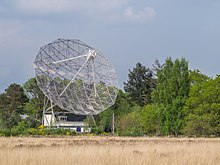astro.wikisort.org - Institution
The Dwingeloo Radio Observatory is a single-dish radio telescope near the village of Dwingeloo (Dutch pronunciation: [ˈdʋɪŋəloː]) in the northeastern Netherlands. Construction started in 1954, and the telescope was completed in 1956. The radio telescope has a diameter of 25 m.[1] At the time of completion it was the largest radio telescope in the world, but it was overtaken in 1957 by the 250 foot (76 m) Lovell Telescope.
 The 25 meter Dwingeloo radio telescope in 2014 | |
| Named after | Dwingeloo |
|---|---|
| Part of | Top 100 of Dutch monuments 1940-1958 |
| Location(s) | Dwingeloo, Drenthe, Netherlands |
| Coordinates | 52°48′43″N 6°23′46″E |
| Telescope style | observatory radio telescope |
| Diameter | 25 m (82 ft 0 in) |
 Location of Dwingeloo Radio Observatory | |
| | |
As of 2000, it was no longer in operation in an official capacity. Since August 2009, the radio telescope has been a national heritage site (rijksmonument).[1] The telescope dish was removed for restoration in June 2012.[2] The "C.A. Muller Radio Astronomy Station" foundation ("CAMRAS" for short) restored the telescope to working order. The dish was remounted in November 2012.[3]
Radio amateurs along with amateur and professional astronomers, use the telescope for projects, one being Earth–Moon–Earth communication, also known as moonbounce, which allows for people on different parts of Earth to communicate via the Moon. In this technique, radio wave signals are aimed at the Moon by one location, bounce off the Moon's surface, and are detected by an antenna at a different location on Earth. The technique of "visual moonbounce", where the digital representation of an image is moonbounced at amateur-radio frequencies, has been developed at the Dwingeloo Telescope. It was later used in the art project "OPTICKS" by interdisciplinary artist Daniela de Paulis[4][5]
The radio telescope is owned by ASTRON, the Netherlands Institute for Radio Astronomy. The site of the Dwingeloo Radio Observatory also houses most of the staff of ASTRON and a test site for the Low Frequency Array radio telescope, LOFAR.
Two galaxies are named after this telescope: Dwingeloo 1 and Dwingeloo 2.
References
- Monumentnummer: 530829 - radiotelescoop[permanent dead link], Rijksdienst voor het Cultureel Erfgoed. Retrieved 20 January 2016.
- Dish Dwingeloo Telescope temporarily dismantled Archived 2017-02-21 at the Wayback Machine, ASTRON, 2012.
- Dish Dwingeloo radio telescope back on tower Archived 2016-12-18 at the Wayback Machine, ASTRON, 2012.
- "OPTICKS and Visual Moonbounce in Live Performance". Leonardo. Retrieved 4 June 2020.
- "opticks.info". Retrieved 4 June 2020.
External links
 Media related to Radiotelescoop Dwingeloo at Wikimedia Commons
Media related to Radiotelescoop Dwingeloo at Wikimedia Commons- Westerhout, Gart (December 1958). "A survey of the continuous radiation from the Galactic System at a frequency of 1390 Mc/s". Bulletin of the Astronomical Institutes of the Netherlands. 14: 215. Bibcode:1958BAN....14..215W.
На других языках
[de] Dwingeloo-Radioteleskop
Das Dwingeloo-Radioteleskop nahe dem Dorf Dwingeloo in der Gemeinde Westerveld im Nordosten der Niederlande ist ein einschüsseliges Radioteleskop mit einem Durchmesser von 25 m. Baubeginn war im Jahr 1954, der Abschluss der Bauphase fiel ins Jahr 1956. Zu dieser Zeit war es das größte Radioteleskop der Welt.- [en] Dwingeloo Radio Observatory
[ru] Радиообсерватория Двингело
Радиообсерватория Двингело (англ. Dwingeloo Radio Observatory, нидерл. Dwingeloo Radiotelescoop) — радиотелескоп в городе Двингело на северо-востоке Нидерландов. Строительство обсерватории началось в 1954 году, создание телескопа завершилось в 1956 году. Диаметр радиотелескопа составляет 25 метров, на момент создания он являлся крупнейшим радиотелескопом в мире[1].Другой контент может иметь иную лицензию. Перед использованием материалов сайта WikiSort.org внимательно изучите правила лицензирования конкретных элементов наполнения сайта.
WikiSort.org - проект по пересортировке и дополнению контента Википедии